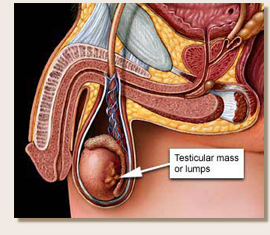 There a
several different ways to treat testicular cancer. Perhaps the most
common start is a Orchiectomy. Once removed, the testicle
can be analyzed by a clinical pathologist to diagnose the stage of the
cancer. The stages are listed below. Other treatment options are Retroperitoneal
Lymph Node Dissection, Chemo, Radiation
and Surveillance.
There a
several different ways to treat testicular cancer. Perhaps the most
common start is a Orchiectomy. Once removed, the testicle
can be analyzed by a clinical pathologist to diagnose the stage of the
cancer. The stages are listed below. Other treatment options are Retroperitoneal
Lymph Node Dissection, Chemo, Radiation
and Surveillance.
ALSO VISIT OUR
ONLINE SUPPORT FORUMS WHERE YOU CAN INTERACT
WITH HUNDREDS OF OTHER ACTIVE MEMBERS!
Stage I
Testicular Cancer
Treatment depends on what the cancer cells look like under a microscope
(cell type). If a tumor called a seminoma is found, treatment will
probably be surgery to remove the testis (radical inguinal
orchiectomy), followed by external-beam radiation to the lymph nodes in
the abdomen. Clinical trials are also being performed on radical
inguinal orchiectomy alone followed by careful testing to see if the
cancer comes back.
If a tumor called a nonseminoma is found,
treatment may be one of the following:
- Radical
inguinal orchiectomy and removal of some of the lymph nodes in
the abdomen (lymph node dissection). Patients may undergo surgery that
will preserve fertility. Blood tests and chest x-rays must be done once
each month for the first year following the operation and at least
every 2 months during the second year. A CT scan, a special kind of
x-ray, may also be done. If results of the tests don't look normal and
the cancer has recurred (come back), the doctor will give the patient
systemic chemotherapy as soon as possible.
- Radical
inguinal orchiectomy alone followed by careful testing to see if
the cancer comes back. The doctor must check the patient and do blood
tests and x-rays every month for 2 years. This option is chosen only if
the tumor has certain special features.
Stage II
Testicular Cancer
Treatment depends on what the cancer cells look like under a microscope
(cell type). If a tumor called a seminoma is found and the tumor is
nonbulky (no lymph nodes can be felt in the abdomen, and no lymph nodes
block the ureters [the tubes that carry urine from the kidney to the
bladder]), treatment will probably be surgery to remove the testis
(radical inguinal orchiectomy). External-beam radiation is then given
to the lymph nodes in the abdomen.
If a tumor called a seminoma is found and the
tumor is bulky (lymph nodes can be felt in the abdomen and/or the lymph
nodes block the ureters, or if a CT scan shows them to be large),
treatment will probably be a radical inguinal orchiectomy followed by
systemic chemotherapy or external-beam radiation therapy.
If a tumor called a nonseminoma is found,
treatment will probably be one of the following:
- Radical
inguinal orchiectomy and removal of the lymph nodes in the
abdomen (lymph node dissection). The doctor will check the patient each
month and do blood tests, chest x-rays, and CT scans. If the test
results are not normal, patients will probably receive systemic
chemotherapy.
- Radical
inguinal orchiectomy and lymph node dissection, followed by
systemic chemotherapy. Blood tests and chest x-rays must be done once
each month for the first year after the operation. CT scans are also
done regularly.
- Radical
inguinal orchiectomy followed by systemic chemotherapy. If
x-rays following chemotherapy show that cancer remains, surgery may be
done to remove the cancer. After the operation, the doctor will check
the patient each month and do blood tests, chest x-rays, and CT scans.
In some cases, chemotherapy may be given before the radical inguinal
orchiectomy.
- Clinical
trials of systemic chemotherapy instead of lymph node dissection
(in selected patients).
Stage III
Testicular Cancer
Treatment depends on what the cancer cells look like under a microscope
(cell type). If a tumor called a seminoma is found, treatment will
probably be surgery to remove the testis (radical inguinal
orchiectomy), followed by systemic chemotherapy. Clinical trials are
testing radical inguinal orchiectomy followed by systemic chemotherapy.
If a tumor called a nonseminoma is found, treatment will probably be
one of the following:
- Systemic chemotherapy. Clinical trials are
testing new chemotherapy drugs.
- Systemic chemotherapy, followed by surgery to
take out any masses that remain to see if there are any cancer cells
left. If cancer cells remain, patients will probably receive more
systemic chemotherapy.
- Clinical trials of systemic chemotherapy.
- Clinical trials of high-dose systemic
chemotherapy with autologous bone marrow transplantation (in some
patients).
Recurrent
Testicular Cancer
Treatment depends on what the cancer cells look like under a
microscope, where the cancer recurred (came back), and other factors.
Treatment options include systemic chemotherapy, high-dose systemic
chemotherapy with autologous bone marrow transplantation, surgery, and
clinical trials testing new chemotherapy drugs.
